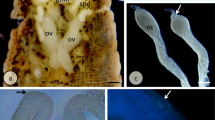Summary
Distribution of rhodamine-conjugated lysozyme injected into the sixteen-cell syncytium comprising the germ-line portion of theDrosophila follicle is shown to be affected by charge. Positive molecules are able to migrate through intercellular bridges from the oocyte to the nurse cells, but are unable to migrate detectably from nurse cells to the oocyte. Their negatively charged counterparts can move from the nurse cells to the oocyte, but are unable to traverse the intercellular bridges in the counter direction. This charge-dependent movement of molecules is accompanied by an electrical potential difference, focused across the nurse cell-oocyte bridges, which makes the nurse cells negatively charged to the oocyte. The addition of insect hemolymph to the physiological salt solution in which the experiments were performed resulted in only a small increase in the transmembrane resistance, but enhanced the potential difference between oocyte and nurse cells from 0.2±0.3 (SE) mV (nurse cells negative) to 2.3±0.45 (SE) mV (nurse cells negative).
Similar content being viewed by others
References
Bohrmann J, Heinrich UR, Dorn A, Sander K, Gutzeit HO (1984) Electrical phenomena and their possible significance in vitellogenic follicles ofDrosophila melanogastor. J Embryol Exp Morph 8 [Suppl]: 151
Bohrmann J, Dorn A, Sander K, Gutzeit HO (1986a) The extracellular electrical current and its variability in vitellogenicDrosophila follicles. J Cell Sci 81: 189–206
Bohrmann J, Gutzeit HO (1987) Evidence against electrophoresis as the principal mode of protein transport in vitellogenic follicles ofDrosophila. Development 101: 279–288
Bohrmann J, Huebner E, Sander K, Gutzeit HO (1986b) Intercellular electrical potential measurements inDrosophila follicles. J Cell Sci 81: 207–221
Chino H (1985) Lipid transport: biochemistry of hemolymph lipophorin. In: Kerkut GA, Gilbert LI (eds) Comprehensive insect physiology, biochemistry ans pharmacology, vol 10. Pergamon Press, Oxford, pp 115–135
Dittman F, Ehni R, Engles W (1981) Bioelectric aspects of the hemipteran telotrophic ovariole (Dysdercus intermedius). Wilhelm Roux's Arch 190: 221–225
Gutzeit HO (1986) Transport of molecules and organelles in meroistic ovarioles in insects. Differentiation 31: 155–165
Hoffman R, Gross L (1975) Modulation contrast microscope. Appl Optics 14: 1169–1176
Huebner E, Sigurdson W (1986) Extracellular currents during insect oogenesis: special emphasis on telotrophic ovarioles. In: Nuccitelli R (ed) Ionic currents in development. AR Liss, New York, pp 155–163
Huebner E, Woodruff RI, Telfer WH 1980 Electrophysiological and structural aspects of nurse cell-oocyte interaction in the telotrophic ovarioles ofRhodinus prolixus. Am. Zool 20: 867
Inoue S (1986) Video microscopy. Plenum Press, New York, p 584
Jaffe LF (1969) On the centripetal course of development, theFucus egg, and self-electrophoresis. Dev Biol [Suppl 3]: 83–111
Jaffe LF, Nuccitelli R (1974) An ultrasensitive vibrating probe for measuring steady extracellular current. J Cell Biol 63: 614–628
Jaffe LF, Overall R (1985) Patterns of ionic current throughDrosophila follicles and eggs. Dev Biol 108: 102–119
Jaffe LF, Woodruff RI (1977) Electrical current patterns through developingCecropia follicles. J Cell Biol 75: 23a
Jaffe LF, Woodruff RI (1979) Large electrical currents traverse developingCecropia follicles. Proc Nat Acad Sci USA 76: 1328–1332
Kiehart DP (1981) Microinjections ofEchinoderm eggs. Apparatus and procedure. In: Wilson L (ed) Methods and perspectives in cell biology. The cytoskeleton, vol, 25 part B, biological systems and functional methods. Academic Press, Orlando, pp 13–31
King RC, Buning J (1983) The origin and functioning of insect oocytes and nurse cells. In: Kerkut GA, Gilbert LI (eds) Comprehensive insect physiology biochemistry and pharmacology. Pergamon Press, New York
Kunkel JG (1986) Dorsoventral currents are associated with vitellogenesis inCockroach ovarioles. In: Nuccitelli R (ed) Ionic currents in Development. AR Liss, New York, pp 165–172
Munz A, Dittmann F (1988) Voltage gradient and microtubules both involved in intracellular protein and mitochondira transport in the telotrophic ovarioles ofDysdercus intermedius. Roux's Arch Dev Biol (in press)
Robb JA (1969) Maintenance of imiginal dises ofDrosophila melanogaster in chemically defined media. J Cell Biol 44: 876–884
Sun YA, Wyman RJ (1987) Lack of an oocyte to nurse cell voltage difference inDrosophila. Neurosci 13: 1139
Telfer WH (1975) Development and physiology of the oocyte-nurse cell syncytium. Insect Physiol 11: 223–319
Telfer WH, Woodruff RI, Hucbner E (1981) Electrical polarity and cellular differentiation in meroistic ovaries. Am Zool 21: 675–686
Verachtert B, De Loof A (1986) Electrical fields around the polytrophic ovarian follicles ofSarcophga bullata and the panoistic folliclesLocusta migratoria. In: Nuccitelli R (ed) Tonic currents in development. AR Liss, New York, pp 173–179
Woodruff RI (1979) Electrotonic junctions inCecropia moth ovaries. Dev Biol 69: 281–295
Woodruff RI, Telfer WH (1973) Polarized intercellular bridges in ovarian follicles of theCecropia moth. J Cell Biol 58: 172–188
Woodruff RI, Telfer WH (1974) Electrical properties of ovarian cells linked by intercellular bridges. NY Aca Sci 238: 408–419
Woodruff RI, Telfer WH (1980) Electrophoresis of proteins in intercellular bridges. Nature 286: 84–86
Woodruff RI, Anderson KL (1984) Nutritive cord connection and dye-coupling of the follicular epithelium of the growing oocytes in the telotrophic ovarioles inOncopeltus fasciatus, the milkweed bug. Wilhelm Roux's Arch 193: 158–163
Woodruff RI, Huebner E, Telfer WH (1986a) Electrical properties of insect ovarian follicles: some challenges of a multicellular system. In: Nuccitelli R (ed) Tonic currents in development. AR Liss, New York, pp 147–154
Woodruff RI, Huebner E, Telfer WH (1986b) Ion currents inHyalophora ovaries: The role of the epithelium and the intercellular spaces of the trophic cap. Dev Biol 117: 405–416
Author information
Authors and Affiliations
Additional information
Supported by NSF Grant # DB-18617
Rights and permissions
About this article
Cite this article
Woodruff, R.I., Kulp, J.H. & LaGaccia, E.D. Electrically mediated protein movement inDrosophila follicles. Roux’s Arch Dev Biol 197, 231–238 (1988). https://doi.org/10.1007/BF02439430
Received:
Accepted:
Issue Date:
DOI: https://doi.org/10.1007/BF02439430




